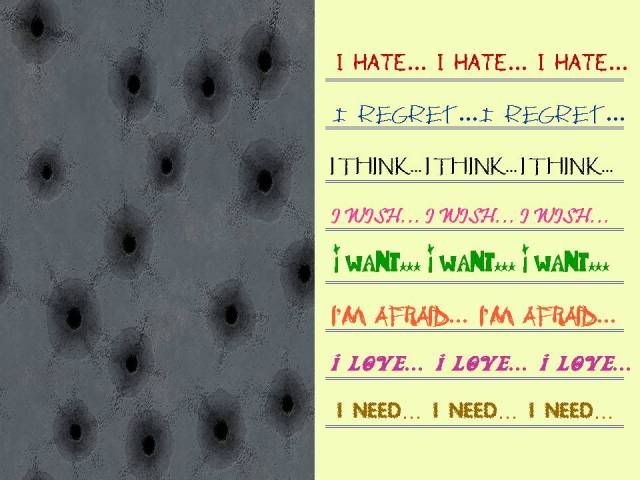 The Healing Power of Your Poetic Soul, Part 3
The Healing Power of Your Poetic Soul, Part 3by Kristy Johnson
Emotions are tricky and often unmanageable for abuse survivors. Because of your experiences, you often have a hard time pinpointing what you ACTUALLY feel at any given moment. You bounce back and forth between extremes of feeling numb or drowning in overwhelming feelings of rage, hatred, loneliness depression, etc. At times it’s difficult to answer the simple question, “How are you feeling today?” Answering the “Why” of certain emotions and figuring out where and what your sensations stem from might seem like you’re trying to penetrate a concrete wall.
This wall of locked up emotions may even be more confusing because of your damaged sense of self. You struggle with low self esteem and frequently live with a broken record, whispering in your head, such lies as: I’m not worthy, I’m stupid, I will never amount to anything because of what happened to me, I’m nobody, I’ll never be ‘normal’, Why express myself, no one is really listening to me anyway, I have nothing of value to add to this life…etc.
It is in those moments when emotions and lies are raging and your broken self feels beyond repair that the concept of the poetic soul, frankly, just ain’t gonna cut it!!! At these chaotic times-- before you can even find the strength to create a calm, meditative space for healing words to flow-- you need a tool, more like a weapon, that will help you break through the concrete wall of your damaged and puzzling emotions.
The following exercise can be such a tool to use during these emotionally intense periods:
In a journal, notebook or computer write a series of ‘I’ declarative statements. ‘I’ declaratives – are statements that begin with the word ‘I’ and are attached to an open-ended phrase that expresses and describes certain thoughts or emotions. For example: I hate…, I regret…, I think…, I wish…, I want…, I’m afraid…, I love…, I want…, etc.
The exercise works like this--
1. Choose the declarative statement you think will help express what you are feeling in the moment. I’ve found the statement I hate… to be very useful when I’m overwhelmed with feelings of rage and anger (the word hate may seem too strong to use if you come from a Christian tradition, if you feel this is the case, may I suggest you read Sallie Culbreth’s founder’s blog article dated April 22, 2010 --http://sallieculbrethcommittedtofreedom.blogspot.com/2010/04/hatred-forbidden-emotion.html before attempting this particular one).
2. If you are writing in a journal or notebook, pick out one that hasn’t been written in and use it for this exercise only. Have colored pens, pencils, crayons or markers to choose from and use a different color to express each declarative statement. For example: red for HATE or ANGRY, pink for LOVE, purple for WISH, blue for REGRET or SORRY, etc. If you choose to use a computer then pick out different fonts to use that you think will visually reflect each declarative statement. Make sure to have the colors or fonts picked out before you begin writing.
3. Leave a space between each statement, in other words each declarative should be on one line, then double space and write another, etc.
4. Keep in mind before you start-- this exercise is meant to break THROUGH your concrete wall, so each statement should fire out of you like machine gun bullets. There is no time for reflection or thinking with this one. Do your best to turn off that inner critic lurking inside and write down the first thing that comes out! Don’t go back and re-read what you wrote, don’t erase, correct spelling or do any editing of what has already been written. JUST WRITE, WRITE, WRITE!
For example, here is how I am feeling at this moment:
I hate… that I feel inadequate to write this article.
I hate…that it’s raining outside.
I hate…that I’m afraid I won’t meet the deadline.
I hate…that this doesn’t’ read as brilliantly as I want it to.
I hate…my inner critic.
5. You will find, after the first attempt, that other ‘I’ declarative statements will feed off those that came before, so that you’ll want to introduce the new statements (remember to use the corresponding color marker or font for each new statement). This will help with pulling apart the confusing mix of feelings that seemed impossible to declare before the exercise.
Here is another example I did in my own healing process:
I’m afraid…of being me.
I love…being me.
I want…to stay being me.
I want…more than this.
I’m afraid…that after reading what I have so far and taking a nap there is this compulsion to erase it all
I’m afraid…of this ugliness towards my [insert specific person you’re dealing with]
I hate…the time I’ve wasted not dealing with this [insert appropriate explicative, if necessary]
I’m sorry…for having written this and even starting this stupid exercise at all.
6. To start with you may want to give yourself a timeframe, say 15-20 minutes. But, if at the end of the timeframe you still feel like the thoughts and feelings you’re expressing are firing out at full blast then, well, let ‘er rip!!! Remember, this is a tool for you alone, you will not be graded or even have to show anyone what you wrote. The process and rhythm of the exercise is up to you and there is no pressure to do it.
What you find out, as a result of this exercise, may not be pretty, in fact, it may bring out some very ugly, scary and devastating truths that are hard to face. But, what you will have is a map of statements that will help lead you to the truth of the what, why and how of your emotional landscape. Hopefully, this tool will be a significant ally to empower you to bravely and honestly manage your difficult emotions and declare to yourself, and possibly to others, who you truly are today as a survivor journeying beyond your abuse.



No comments:
Post a Comment